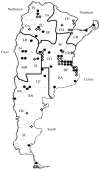Automated use of WHONET and SaTScan to detect outbreaks of Shigella spp. using antimicrobial resistance phenotypes
- PMID: 19796449
- PMCID: PMC4093803
- DOI: 10.1017/S0950268809990884
Automated use of WHONET and SaTScan to detect outbreaks of Shigella spp. using antimicrobial resistance phenotypes
Abstract
Antimicrobial resistance is a priority emerging public health threat, and the ability to detect promptly outbreaks caused by resistant pathogens is critical for resistance containment and disease control efforts. We describe and evaluate the use of an electronic laboratory data system (WHONET) and a space-time permutation scan statistic for semi-automated disease outbreak detection. In collaboration with WHONET-Argentina, the national network for surveillance of antimicrobial resistance, we applied the system to the detection of local and regional outbreaks of Shigella spp. We searched for clusters on the basis of genus, species, and resistance phenotype and identified 19 statistical 'events' in a 12-month period. Of the six known outbreaks reported to the Ministry of Health, four had good or suggestive agreement with SaTScan-detected events. The most discriminating analyses were those involving resistance phenotypes. Electronic laboratory-based disease surveillance incorporating statistical cluster detection methods can enhance infectious disease outbreak detection and response.
Conflict of interest statement
None.
Figures




References
-
- Leal J, Laupland KB. Validity of electronic surveillance systems : a systematic review. Journal of Hospital Infection. 2008;69:220–229. - PubMed
-
- Overhage JM, Suico J, McDonald CJ. Electronic laboratory reporting : barriers, solutions and findings. Journal of Public Health Management and Practice. 2001;7:60–66. - PubMed
-
- Wurtz R, Cameron BJ. Electronic laboratory reporting for the infectious diseases physician and clinical microbiologist. Clinical Infectious Diseases. 2005;40:1638–1643. - PubMed
Publication types
MeSH terms
Grants and funding
LinkOut - more resources
Full Text Sources
Medical
Miscellaneous

